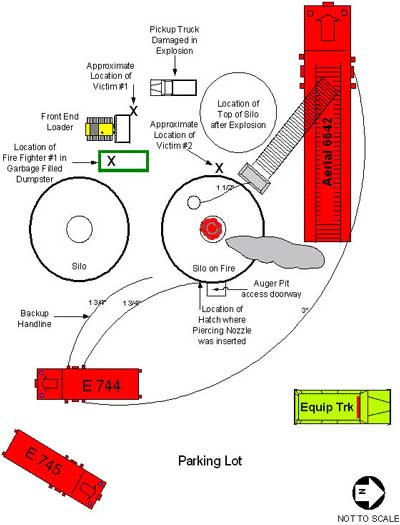 |
| Diagram. Aerial view of incident scene after 1997 explosion |
Is anyone out there reading these accident reports prepared by the United States Fire Administration (1997) and NIOSH (2003)? Doesn't appear anyone is especially with the multitude of catastrophic incidents mirrored after each other like reruns on the television.
Time is way overdue for firefighting training on the practical aspects of combating combustible dust related fires. We already know about the physicochemical properties of combustible dust with the wealth of literature out there. Now is the time to get down dirty out on the training fire ground.
A real concern is in these two accident reports is continued mention of oxygen-limiting silos. This is incorrect as they were no longer oxygen-limiting silos but instead modified oxygen-limiting silos. Big difference between the two. Adding water to the top of any silo in conjunction with simultaneously opening access doors at the bottom and poking around with smoldering contents is wrought with danger. Do you feel lucky?
U.S. Fire Administration Fire Investigations Program:The U.S. Fire Administration develops reports on selected major fires throughout the country. The fires usually involve multiple deaths or a large loss of property. But the primary criterion for deciding to do a report is whether it will result in significant “lessons learned.” In some cases these lessons bring to light new knowledge about fire--the effect of building construction or contents, human behavior in fire, etc...
Resources:
Industrial Silo Fire and Explosion1997 USFA
NIOSH LODD Report 2004
NIOSH LODD Report 2004










 RSS Feed Subscribe
RSS Feed Subscribe